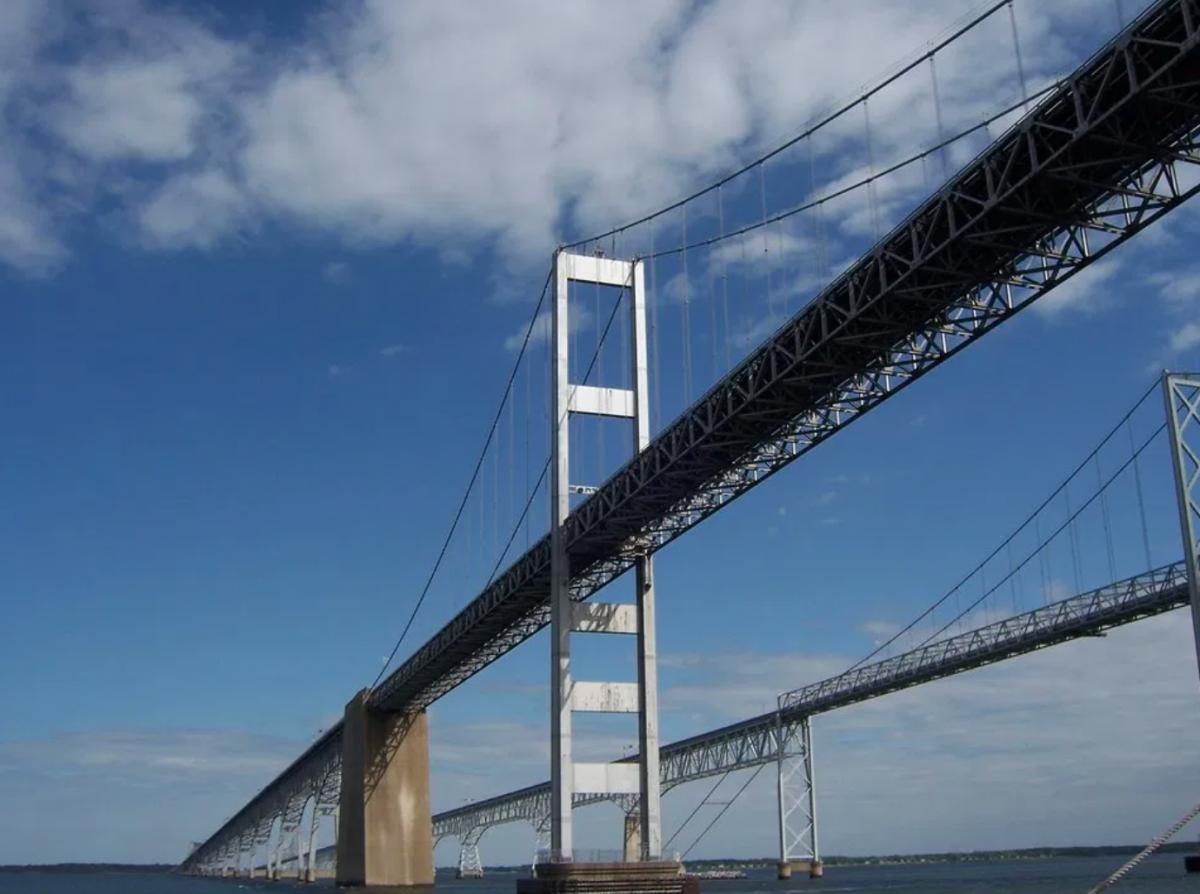A transportation consultant hired by an Eastern Shore environmental group said the state has not justified its pursuit of a third Bay Bridge crossing, concluding that the current spans are likely to last several more decades.
AKRF, a Hanover, Md.-based environmental planning and engineering services firm, also questioned the traffic projections the state used in launching its bid to build a new span across the Chesapeake Bay.
Numbers used by the Maryland Transportation Authority (MdTA) over-stated future growth in the number of vehicles that will be crossing the water, analysts concluded. The authority owns and operates the bridge, and is leading the Hogan administration’s push for a third crossing.
The review of MdTA’s methodology was commissioned by the Queen Anne’s Conservation Association, an environmental group opposed to sprawl. The AKRF analysis, which was presented to the association in December, was provided to Maryland Matters this week.
The report comes amid a delay in the release of a key document, the Draft Environmental Impact Statement, a review required under the National Environmental Policy Act. The delay has prompted speculation about the state’s commitment to the project.
Using a “Life Cycle Cost Analysis” that MdTA conducted in 2015, AKRF engineers determined that the existing bridge spans “can be safely maintained through 2065 with currently programmed and anticipated rehabilitation and maintenance work.”
Beyond 2065, the authority found, the bridge may require major rehabilitation but would not be structurally deficient or functionally obsolete.
“Based on the conclusions of AKRF’s study of traffic congestion and operations on the bridge, and MDTA’s Life Cycle Study of the bridge’s structural integrity, there will not likely be a need for a replacement bridge by 2040 for either traffic or structural purposes,” the firm concluded.
Shortly after Gov. Lawrence J. Hogan Jr. (R) announced plans to pursue a third span in 2016, the state’s analysts predicted that weekday traffic would increase 23% by 2040 (from 69,000 vehicles to 84,000) and that summer weekend traffic would increase 14% (from 119,000 vehicles per day to 135,000).
But AKRF called the state’s analysis into question.
“The MDTA model starts with existing traffic count data from 2017 that leads to biased findings because it only captures one day of weekend traffic from August, which was much higher than an average summer weekend day,” analysts said.
“Our estimates rely on historic growth trends over more than 15 years for summer weekend traffic and the last five years for weekday traffic to present an independent traffic growth forecast,” they added.
MdTA spokesman John Sales said the state data was collected over a two-week period.
“The average weekday data was collected in late April; the summer weekend day data was collected in early August,” he said in an email.
AKRF estimated that bridge traffic would increase only modestly over the next two decades, though the firm conceded that multiple issues — including the growth in telework, the rate of development on the Eastern Shore, and future dips in the economy — make it difficult to project with confidence.
Jay Falstad, executive director of the Queen Anne’s Conservation Association, said the report reinforced his belief that the state’s traffic projections are “over-inflated.”
“The numbers that the state is using are just exaggerated,” he added.
Decision to delay bridge study raises questions
MdTA was scheduled to release the draft environmental report for the bridge project last fall, but the authority quietly pushed that back to December. Officials then decided to keep the DEIS under wraps even longer.
An agency spokesman told the Capital Gazette in January that officials delayed the the release of the study due to the COVID-19 pandemic.
“Proceeding with publishing the DEIS and scheduling public hearing would not have been a safe choice while health officials were telling Marylanders they would be safer at home,” Sales told Maryland Matters on Tuesday. “This led us to revisit our roll-out schedule with our federal partners at the Federal Highway Administration.”
That rationale appears to contradict the practice the Maryland Department of Transportation has used on other projects.
The State Highway Administration, an MDOT sub-unit, held a series of public hearings on the I-495/I-270 road-widening project last year. Some were held virtually, others were held in large hotel ballrooms, where staff and the public could maintain proper distancing.
And on Jan. 15, the Federal Railroad Administration, the Maryland Transit Administration (another MDOT unit), the Maryland Economic Development Corporation and Baltimore-Washington Rapid Rail released a draft environmental statement for the Super-Conducting Magnetic Levitation train — known as MAGLEV — despite the pandemic.
An MdTA spokesman declined to explain the inconsistency.
He said the authority expects to release the Bay crossing DEIS and open the public comment period in late February, with both virtual and in-person hearings.

Queen Anne’s County Commissioner James Moran (R)
“I don’t believe it, honestly,” said Queen Anne’s County Commission chairman James Moran (R) of the reason for delaying the study. “What that means is Hogan’s going to be able to get out of office without funding Phase 2 of the [National Environmental Policy Act study]. My opinion.”
Moran has advocated for a westbound, beach-season toll, which he maintains would raise enough money to fund the study and reduce summertime backups at the existing bridge.
“I hate to say it’s smoke-and-mirrors,” he said of the authority’s explanation. “We’re trying to be constructive in our dialogue, but it’s a struggle.”
Anne Arundel County Executive Steuart Pittman (D) also questioned the delay.
“I assumed that the reason was that the governor doesn’t have a plan to fund a third span and that the public doesn’t support spending some $7 billion on a third span after having cut the Red Line in Baltimore, which was less than half [the cost],” he said.
“When you look at the way they came up with their projections of future traffic on the bridge, it was based on a projection of sprawl development on the Eastern Shore,” Pittman added. “Most residents of the Eastern Shore like being a rural area, and they don’t want their farms turned into suburban developments.”
Although the state initially studied 14 potential bridge crossing sites, Hogan declared in 2019 that the site adjacent to the currents spans is “the only one option I will ever accept.”
Pittman, who opposes a third span, said even if in-person public hearings have to be delayed due to the pandemic, MdTA should release its report now. “If the study is done, they should show it to us,” he said. “Nobody likes to have multi-million dollar, taxpayer-funded work by consultants hidden from public view, so let’s see it.”
Policy consultant Gary V. Hodge, a former elected official in Southern Maryland, said the impact of the pandemic on toll revenues and the lack of traffic congestion at the Bay Bridge — thanks in part to the administration’s transition to all-electronic tolling — has taken the wind out of the project’s sails.
“Best to leave the Sturm und Drang over a new Bay Bridge for the next governor,” Hodge said. “There won’t be any groundbreaking or ribbon-cutting on it in the next two years anyway.”
John B. Townsend II, director of media and government affairs for AAA Mid-Atlantic, also said he was “astonished” by the delay.
“We live in a Zoom world,” he said. “I think you could have held the public hearings that way.”
Townsend said it’s important that the state move forward with plans for a third span, noting that a major bridge collapsed in Minnesota in 2007. “How long do we forsake infrastructure like that? Any span that size, over a body of water like the Chesapeake Bay, cannot last forever.”
Townsend noted that MDOT officials have been consumed with the controversy over delays and cost overruns associated with the Purple Line light rail project, and with the selection of a private-sector partner for the I-495/I-270 project, which is expected to be announced in the coming days.
“I wonder if there is some kind of fatigue going on,” he said. “Just to save the Purple Line took an all-out effort. I think it was demoralizing for the whole department because it was a signature project.”
By Bruce DePuyt


